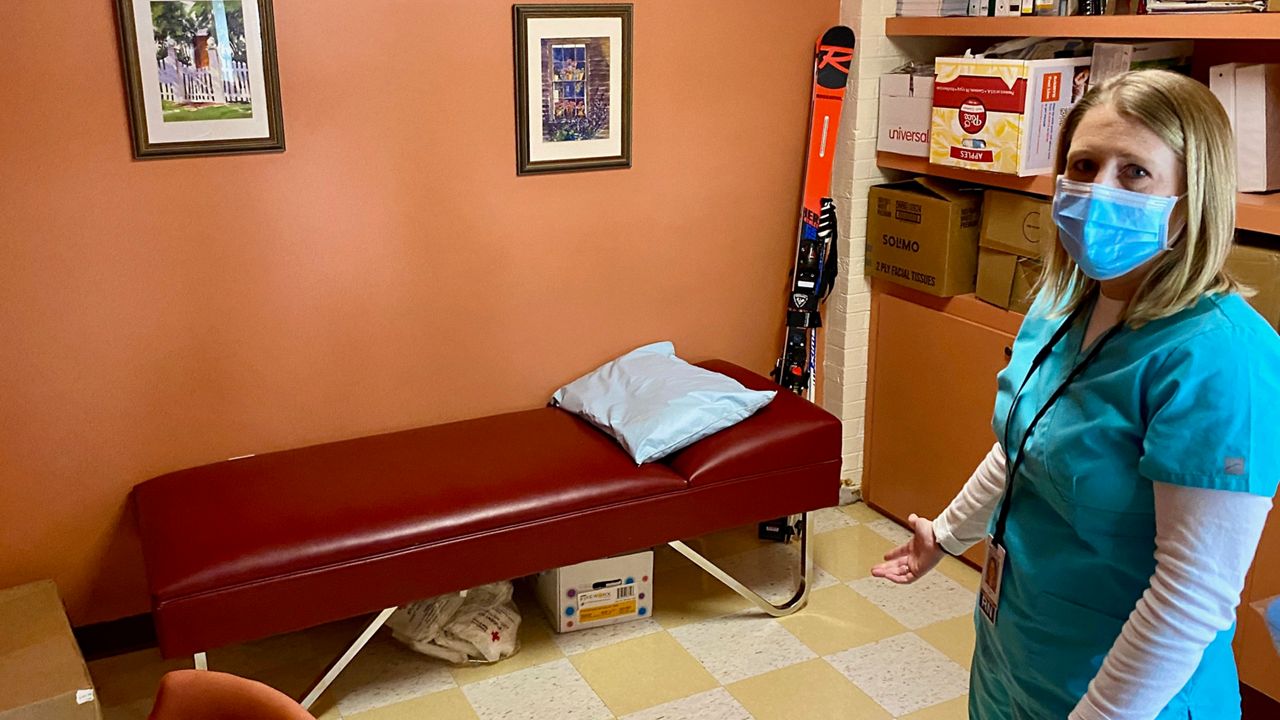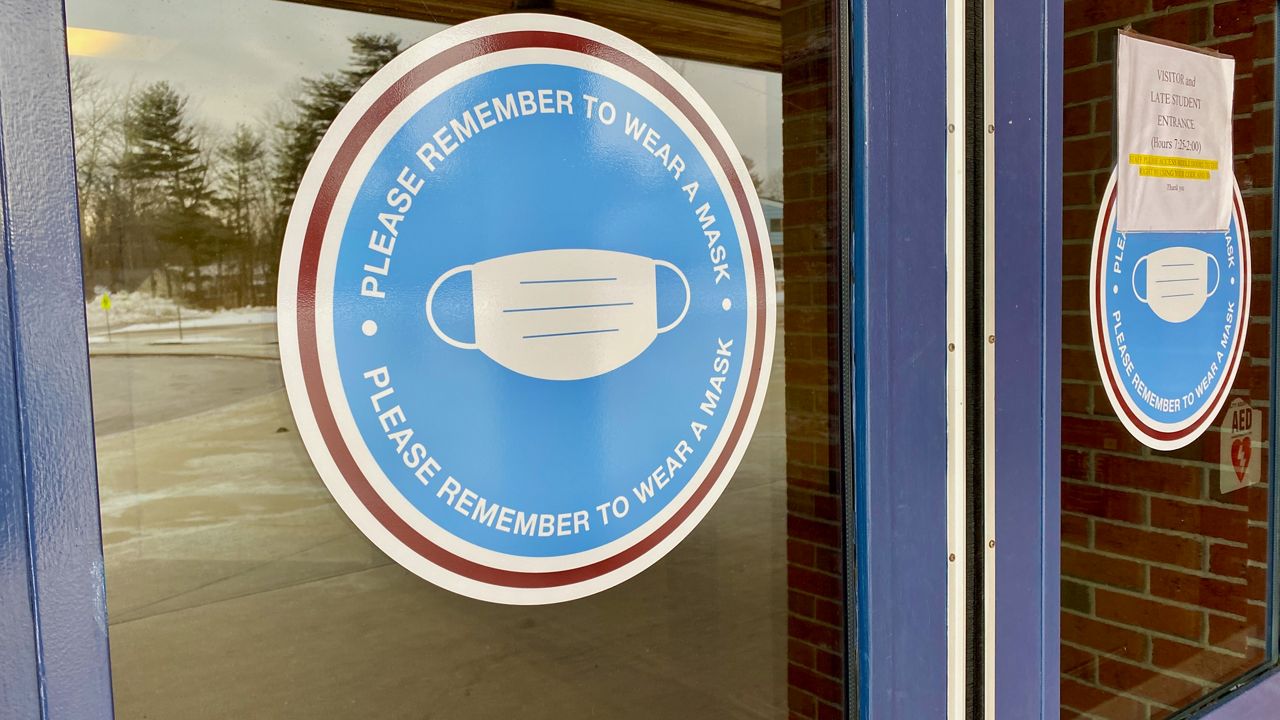At Windham High School, signs of the pandemic’s lingering impacts on daily life were clearly visible. Stickers on the front door asked visitors to be masked, and everyone — staff and students alike — was masked inside the building. When school nurse Karry Joly greeted a reporter, her first words said it all.
“I would shake your hand, but that’s not the proper way to do things,” she said.
Windham, like many high schools statewide, is still trying to maintain some degree of normalcy despite the aggressive omicron variant of the coronavirus rampaging across Maine. Spectrum News checked in with Windham High School last week to get a snapshot of the challenges schools are still dealing with, as the nation enters its third year of the pandemic.
Joly, who has been a nurse for 23 years, never imagined she’d be on the front lines of fighting a global pandemic. She said she and the other five nurses spread throughout the district are finding ways to manage but the stress weighs on them.

“We’re tired. We’re burned out. We feel overwhelmed,” she said. “(We ask ourselves) how long can we do this?”
Like medical personnel everywhere, she also has to deal with non-COVID-related ailments, ranging from diabetes to seizures, along with the pandemic.
“We have the flu, we have strep throat, we have all the other normal stuff,” she said.
Principal Ryan Caron was busier than usual. Staff were preparing for midterms (teachers were not available to be interviewed), but the school was still adjusting to in-person learning after going totally remote for four days the previous week, from Jan. 11-14. He has extended the end of the semester by two days to make sure students get to meet with all their teachers in person.
“We’re just making adjustments on the fly,” he said.
Remote learning is not a new thing anymore for Windham High School. Caron said the school, like most schools in Maine, was fully remote by the end of the 2019-2020 school year, when the pandemic was in its initial stages.
The following school year, 2020-2021, he said the school was operating under a hybrid model of part-time remote and part-time in-person study. There was also the option for students to opt for fully remote learning if they wanted, and about 150 out of the school’s 925 students did that, but Caron said students were often changing their minds, going to and from the remote-only option.
“That was a trick to manage, as kids went back and forth,” he said.
Now, Caron said, the school is functioning with full in-person instruction — something he, like school officials throughout the state, regards as better in terms of teachers being able to directly support the students.
“In person is far superior than online,” he said.
Keeping it in person has been tricky, however.
So far this academic year, the school went remote for a day in November, a day at the beginning of January, and the four-day period from Jan. 11-14. That four-day period of remote learning was necessary, Caron said, because about 50 to 70 students were out for COVID-related reasons. About 20 staff members were also unable to come into the school for similar reasons, he said.
Despite the pandemic, Caron said one positive change has been attendance. In October 2021 alone, he said, student attendance was better than pre-pandemic levels.
“The students really want to be here,” he said.
On Wednesday morning, Joly’s office was quiet with no patients – a rarity. She keeps stockpiles of masks, gloves and COVID testing kits on hand in case someone comes in with symptoms. Once upon a time, she said, sniffles or a mild fever were no big deal, but today she takes no chances.
“I think it’s harder because we always have to rule out COVID first,” she said.
Her office’s “quiet room,” typically reserved for students who might be going through emotional issues, is now set up as a quarantine room for any student who has symptoms and needs to wait for test results.
“If we have a symptomatic kid, we want to make sure we keep them away from the healthy kids,” she said.
One piece of good news for the school and districts statewide came earlier this month when the Maine Center for Disease Control and Prevention and the state Department of Education opted to eliminate contact tracing. RSU14 Superintendent Christopher Howell said school officials had been required to notify parents of any student who might have come into contact with another student who tested positive.
Before the omicron variant came to Maine, Howell said, that might have been a good idea, but given how fast the disease has spread that’s no longer feasible, and he is relieved to see the state relax that requirement.
“It just was not workable. Every kid in every classroom was considered to be a close contact. It was a tremendously burdensome amount of work,” he said.
Howell said last week alone, there were 116 positive cases among students and staff districtwide, and 217 cases the week before that.
Howell is not alone in his assessment. Superintendents statewide have been protesting the contact tracing requirement since the emergence of the omicron variant, prompting Maine CDC Director Dr. Nirav Shah to hold several meetings with regional school superintendents in December and January.
At Windham High School, Caron agreed that contact tracing had become a logistical nightmare. As an example from earlier in the month, he said, 10 students tested positive at one point, which meant notifying the parents of 521 students, more than half the student body.
Joly said with the volume and prevalence of the omicron variant, such mass-mailing is almost redundant.
“Everyone should assume they’ve been in contact with someone who has COVID,” she said.





